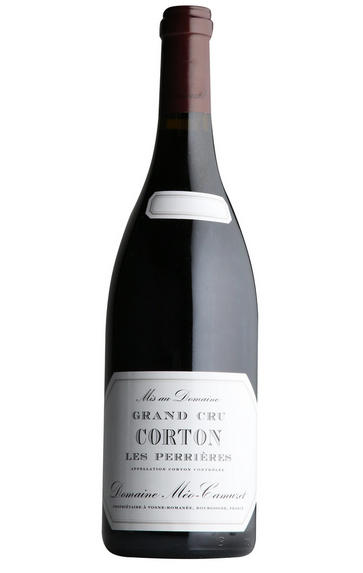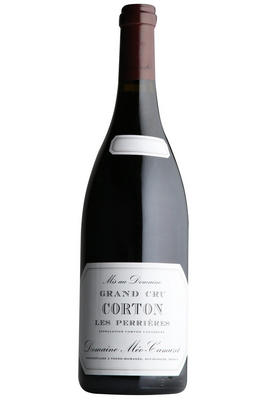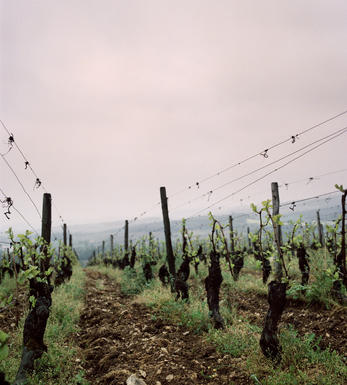
2018 Corton, Les Perrières, Grand Cru, Domaine Méo-Camuzet, Burgundy

Critics reviews
A little dark centre here with concentrated fruit on the nose, and a glossiness partly from the oak. A touch of reduction or maybe the 10% stems which have been added back. This is quite severe at the back: this time the stems are to give flesh, by improving the entry on the palate.
Jasper Morris MW, InsideBurgundy.com (November 2019)
From a .68 ha parcel.
A moderately toasty nose combines notes of poached plum with those of earth, violet and a wisp of gaminess. There is both good volume and density to the bigger and richer if less energetic medium weight plus-sized flavours that terminate in a lingering finish where the supporting tannins coat the palate.
Drink from 2033 onward
Allen Meadows, Burghound.com (January 2020)
The 2018 Corton-Perrières Grand Cru includes a few stems in the blend this year and was one of two parcels picked on August 29. It has a generous bouquet of blueberry, raspberry and wild strawberry fruit, plus a touch of blood orange in the background. The palate is medium-bodied with supple tannins that frame a sweet core of red fruit. A little lower in acidity than previous vintages, revealing white pepper and bay leaf toward the finish. I think this will offer much pleasure in its youth.
Drink 2023 - 2038
Neal Martin, Vinous.com (January 2020)
The 2018 Corton Grand Cru Les Perrières is also a beautiful wine in the making, offering up notes of sweet red berries, cherries, rose petals and espresso roast that's still youthfully primary. On the palate, the wine is medium to full-bodied, chalky and incisive, with terrific concentration, fine tannins and a beautifully defined finish. This, too, will require time, but it's less blocky and muscular than the En Rognet.
The 2018 vintage has turned out brilliantly at Domaine Méo-Camuzet, delivering exquisitely balanced wines that were strikingly expressive, even demonstrative, when I visited in late November. Méo's wines see quite a long élevage, and they can often be a little structural and introverted in the fall following the vintage, but these 2018s were simply singing.
Méo began his harvest on August 29, and like a number of his peers, he observes that his parcels didn't necessarily ripen in the usual order in 2018, with his holdings in Corton in particular accumulating sugar very rapidly. But careful attention to the date of harvest meant that most wines in the cellar are around 13.5% alcohol this year, with only a couple hitting 14%. Beautifully balanced and structurally refined, the Méo-Camuzet wines will enjoy very long lives this year, and they come warmly recommended.
William Kelley, Wine Advocate (January 2020)
About this WINE

Meo-Camuzet
Méo-Camuzet is one of the most renowned estates in Burgundy today. Until 1988, its holdings were leased out to other vignerons who share-cropped the land; much of the wine was sold in bulk.
Jean-Nicolas Méo’s arrival at the domaine in ’89 signalled a change in direction at the property, with more wines being estate-bottled. Since 2007, everything has been kept by the domaine.
Méo-Camuzet has Grands Crus sites along with of some of the finest Premier Cru vineyards of Nuits-St-Georges and Vosne-Romanée.
In addition to these wonderful holdings, Jean-Nicolas has established a high-quality négociant business – Méo-Camuzet Frère & Soeurs – buying fruit from trusted growers across the Côte. Vineyard work is overseen by the team at Méo-Camuzet; the wines are of the same excellent quality as those of the domaine.

Corton-Charlemagne
There are two specific Charlemagne vineyards, En Charlemagne and Le Charlemagne, making up half the Corton-Charlemagne appellation, while white grapes grown in seven other vineyards (see list below) may also be sold as Corton-Charlemagne. As a result there can be a wide divergence in style between a south-facing location such as Pougets, which needs picking right at the start of the harvest, and the western slopes in Pernand-Vergelesses which might be picked several weeks later. The underlying similarity though comes from the minerality of the soil.
En Charlemagne lies at the border with Aloxe-Corton. The hillside faces west and fine, racy white wines can be made, but the Grand Cru appellation has been extended right up to the village of Pernand itself, by which time the exposition is north-west and the valley has become noticeably more enclosed. The final sector was only promoted in 1966, and probably should not have been.
Le Charlemagne is the absolute heartland of the appellation, facing south-west, thus avoiding the risk of over-ripeness which can afflict the vines exposed due south. If I had Corton-Charlemagne vines here I would be tempted to let the world know by labelling the wine as Corton-Charlemagne, Le Charlemagne.
Two producers to my knowledge also have some Pinot Noir planted here – Follin-Arbelet and Bonneau du Martray. Both make attractive wines but neither, to my mind, justifies Grand Cru status for red wine, lacking the extra dimensions of flavour one hopes for at the highest level. This is not the producers’ fault, but a reflection of the terroir.

Pinot Noir
Pinot Noir is probably the most frustrating, and at times infuriating, wine grape in the world. However when it is successful, it can produce some of the most sublime wines known to man. This thin-skinned grape which grows in small, tight bunches performs well on well-drained, deepish limestone based subsoils as are found on Burgundy's Côte d'Or.
Pinot Noir is more susceptible than other varieties to over cropping - concentration and varietal character disappear rapidly if yields are excessive and yields as little as 25hl/ha are the norm for some climats of the Côte d`Or.
Because of the thinness of the skins, Pinot Noir wines are lighter in colour, body and tannins. However the best wines have grip, complexity and an intensity of fruit seldom found in wine from other grapes. Young Pinot Noir can smell almost sweet, redolent with freshly crushed raspberries, cherries and redcurrants. When mature, the best wines develop a sensuous, silky mouth feel with the fruit flavours deepening and gamey "sous-bois" nuances emerging.
The best examples are still found in Burgundy, although Pinot Noir`s key role in Champagne should not be forgotten. It is grown throughout the world with notable success in the Carneros and Russian River Valley districts of California, and the Martinborough and Central Otago regions of New Zealand.


Buying options
Add to wishlist
Description
The 2018 Corton-Perrières Grand Cru includes a few stems in the blend this year and was one of two parcels picked on August 29. It has a generous bouquet of blueberry, raspberry and wild strawberry fruit, plus a touch of blood orange in the background. The palate is medium-bodied with supple tannins that frame a sweet core of red fruit. A little lower in acidity than previous vintages, revealing white pepper and bay leaf toward the finish. I think this will offer much pleasure in its youth.
Drink 2023 - 2038
Neal Martin, Vinous.com (January 2020)
wine at a glance
Delivery and quality guarantee